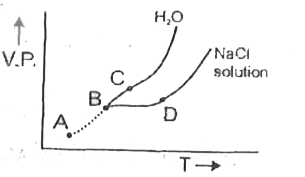The decreases in the freezing point of an aqueoues solution of a substance is and that in the freezing point of benzene solution of the same substance is . Explain the difference in . The substance:
dissociates in the aqueous solution as well as in the benzene solution
forms complexes in solution
associates in the benzene solution
dissociates in the aqueous solution and not in the benzene solution
The correct Answer is:D
To explain the difference in the decrease in freezing point (ΔT) of an aqueous solution and a benzene solution of the same substance, we can follow these steps:
Step 1: Understand the Concept of Freezing Point Depression
The freezing point depression is a colligative property, which means it depends on the number of solute particles in a solution rather than the identity of the solute. The formula for freezing point depression is given by:
ΔTf=i⋅Kf⋅m
where:
- ΔTf = freezing point depression
- i = Van't Hoff factor (number of particles the solute dissociates into)
- Kf = freezing point depression constant of the solvent
- m = molality of the solution
Step 2: Compare the Freezing Point Depression Values
Given:
- For the aqueous solution, ΔTf=1.395K
- For the benzene solution, ΔTf=1.280K
From these values, we can see that the freezing point depression is greater in the aqueous solution than in the benzene solution.
Step 3: Analyze the Van't Hoff Factor (i)
The difference in the freezing point depression can be attributed to the Van't Hoff factor (i). The Van't Hoff factor indicates how many particles the solute produces in solution:
- A higher i value means more particles, leading to a greater freezing point depression.
- A lower i value means fewer particles, resulting in a smaller freezing point depression.
Since the freezing point depression is greater in the aqueous solution, we can conclude that the Van't Hoff factor for the solute in the aqueous solution is greater than that in the benzene solution.
Step 4: Conclusion
The difference in the freezing point depressions indicates that the solute dissociates or associates differently in the two solvents. Specifically:
- The solute likely dissociates in the aqueous solution, contributing to a higher i.
- In the benzene solution, the solute may not dissociate effectively, leading to a lower i.
Thus, the difference in ΔT can be explained by the varying degrees of dissociation or association of the solute in the two solvents.
The freezing point depression is a colligative property, which means it depends on the number of solute particles in a solution rather than the identity of the solute. The formula for freezing point depression is given by:
ΔTf=i⋅Kf⋅m
where:
- ΔTf = freezing point depression
- i = Van't Hoff factor (number of particles the solute dissociates into)
- Kf = freezing point depression constant of the solvent
- m = molality of the solution
Given:
- For the aqueous solution, ΔTf=1.395K
- For the benzene solution, ΔTf=1.280K
The difference in the freezing point depression can be attributed to the Van't Hoff factor (i). The Van't Hoff factor indicates how many particles the solute produces in solution:
- A higher i value means more particles, leading to a greater freezing point depression.
- A lower i value means fewer particles, resulting in a smaller freezing point depression.
The difference in the freezing point depressions indicates that the solute dissociates or associates differently in the two solvents. Specifically:
- The solute likely dissociates in the aqueous solution, contributing to a higher i.
- In the benzene solution, the solute may not dissociate effectively, leading to a lower i.
Topper's Solved these Questions
- SOLUTIONSBOOK - ALLENCHAPTER - SOLUTIONSEXERCISE - EXERCISE-03
22 Videos
- SOLUTIONSBOOK - ALLENCHAPTER - SOLUTIONSEXERCISE - EXERCISE-04 [A]
17 Videos
- SOLUTIONSBOOK - ALLENCHAPTER - SOLUTIONSEXERCISE - EXERCISE -01
53 Videos
- S-BLOCK ELEMENTS BOOK - ALLENCHAPTER - S-BLOCK ELEMENTS EXERCISE - EXERCISE -3
1 Videos
- Some Basic Concepts of Chemistry (Mole concept)BOOK - ALLENCHAPTER - Some Basic Concepts of Chemistry (Mole concept)EXERCISE - All Questions
39 Videos
Similar Questions
Knowledge Check
The lowest freezing point of 0.1 M aqueous solution is of:
AK2SO4BNaClCUreaDGlucose
An aqueous solution of sugar is taken in a beaker. At freezing point of solution
View Solution
Freezing point of solution is marked as
View SolutionThe freezing point of equimolal solution will be highest for :
View SolutionSolution with highest freezing point is
View Solution0.1 M aqueous solution of K4[Fe(CN)6] will have the same freezing point as 0.1 M aqueous solution of
View SolutionA 1.24 M aqueous solution of KI has a density of 1.15gcm−3. What is the freezing point of the solution if the KI is completely dissociated in the solution?
View SolutionIf 0.2 molal aqueous solution of a weak acid (HA) is 40% ionised then the freezing point of the solution will be (K_f for water = 1.86degC/m
View Solution
